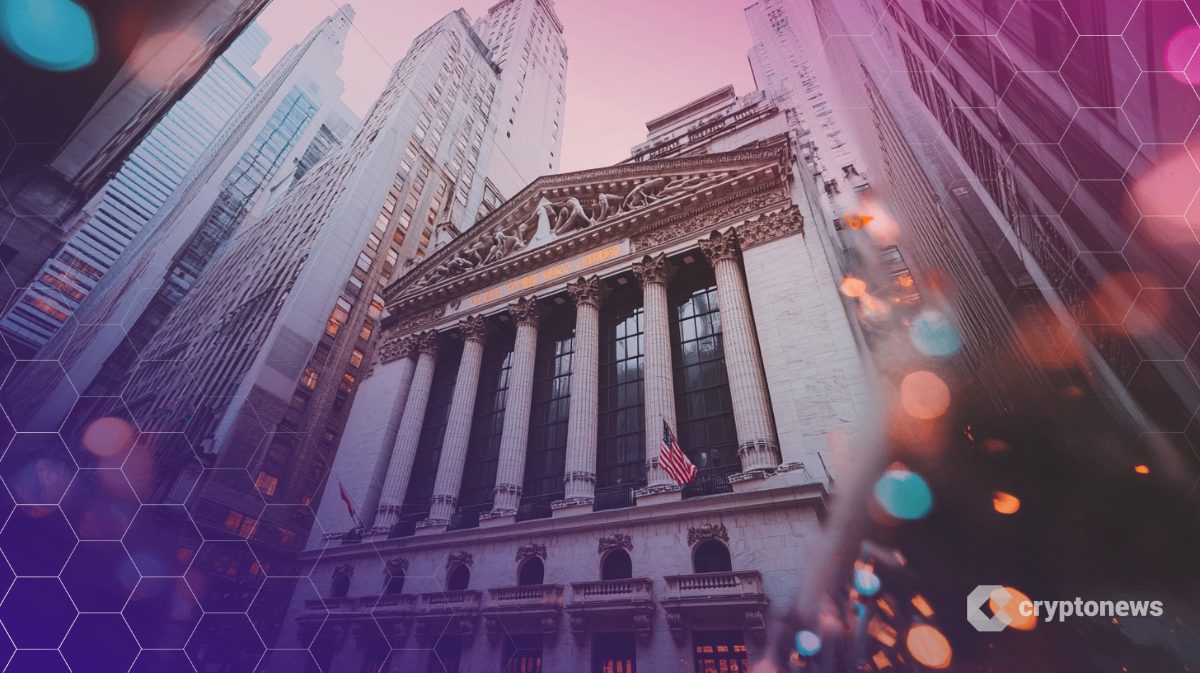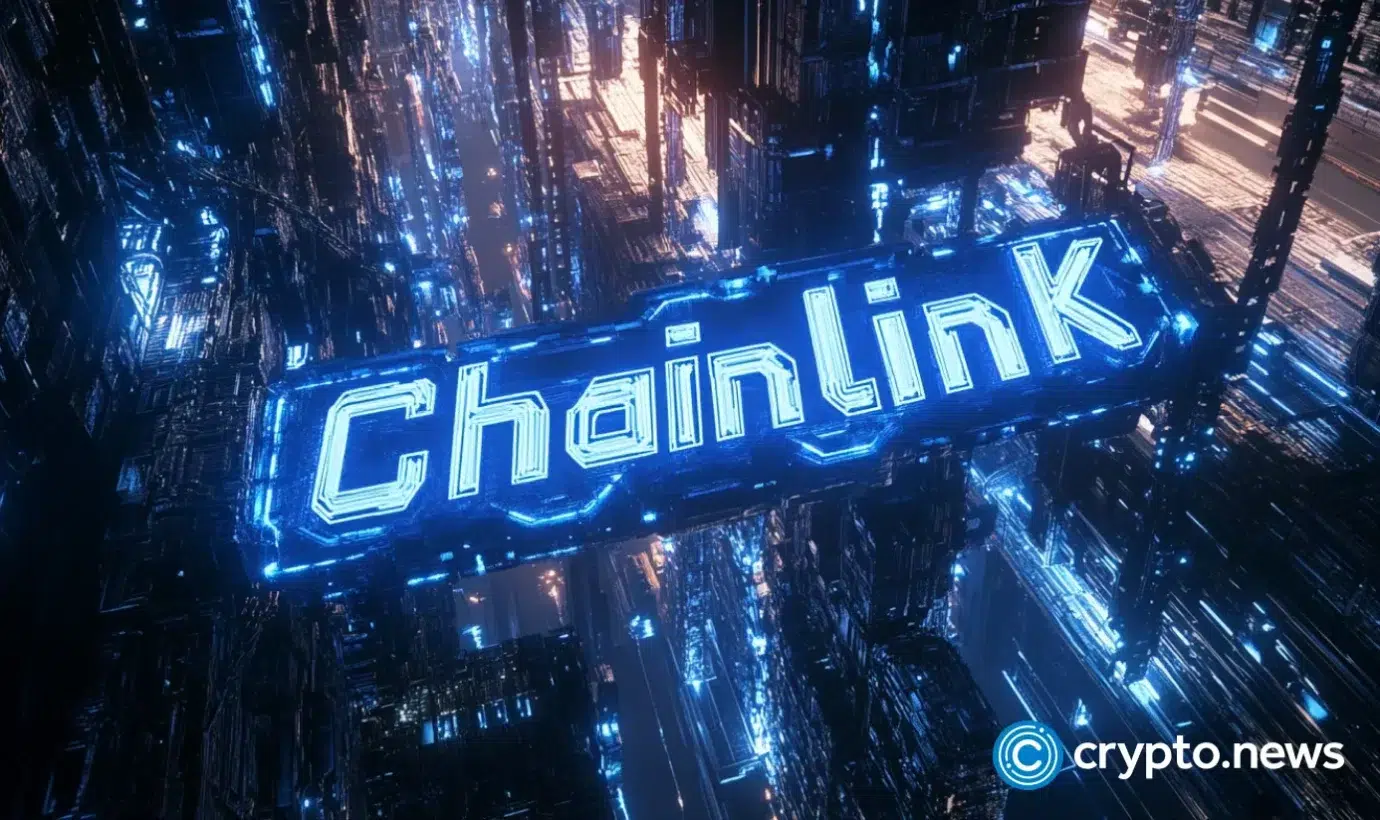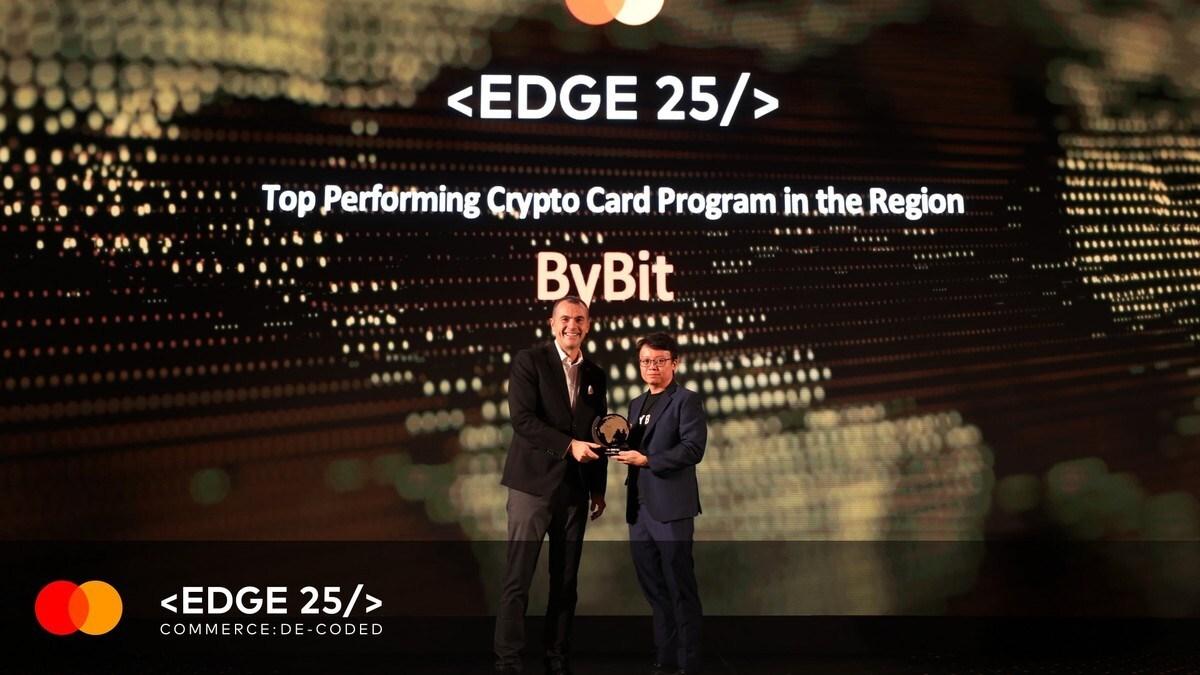TokenizationLive Feed
Tokenization breaking news and instant alerts. Crypto Feed's minimalist interface delivers verified headlines, price movements, and protocol updates the moment they happen. Fast, focused, no fluff.
- LIVE
 SEC Poised to Approve HBAR ETF — Hedera’s Gregg Bell Calls It ‘New Chapter’ for Regulated Crypto Access
SEC Poised to Approve HBAR ETF — Hedera’s Gregg Bell Calls It ‘New Chapter’ for Regulated Crypto AccessThe U.S. Securities and Exchange Commission (SEC) is expected to approve the first Hedera and Litecoin exchange-traded funds (ETFs), according to Bloomberg analyst Eric Balchunas, who confirmed that listing notices for Bitwise Solana, Canary Litecoin, and Canary HBAR have been posted and are scheduled to go live on October 28. Confirmed. The Exchange has just posted listing notices for Bitwise Solana, Canary Litecoin and Canary HBAR to launch TOMORROW and grayscale Solana to convert the day after. Assuming there’s not some last min SEC intervention, looks like this is happening. https://t.co/bHwRnc1jsn— Eric Balchunas (@EricBalchunas) October 27, 2025 The development marks an important milestone for the digital asset industry in 2025, showing growing acceptance of blockchain networks with real-world use cases and institutional-grade infrastructure.A Milestone for Regulated Digital Asset AccessGregg Bell, Chief Business Officer at the Hedera Foundation, describes the approval as a watershed moment for both investors and the broader ecosystem. “With Hedera’s ETF filing approved, a new chapter opens for our ecosystem and the industry at large,” Bell said. “For the first time, investors can gain regulated access to HBAR, a network powering real-world use cases at scale — from tokenized assets to sustainability markets. Supported by the Hedera Governing Council of Fortune 500 organizations, this milestone isn’t just about financial exposure; it’s about showcasing Hedera’s role as critical infrastructure for the future of global finance and accelerating adoption across both institutional and retail markets,” explains Bell. Hedera’s governing body includes major global enterprises such as Google, IBM, Standard Bank, and Boeing, giving it one of the strongest enterprise governance frameworks in the blockchain industry. The introduction of an HBAR ETF provides a regulated gateway for institutional investors to gain exposure to a network already facilitating enterprise-grade tokenization, carbon credit tracking, and digital identity solutions.Industry Reaction: A Broader Shift in Institutional AccessThe ETF approvals are part of a wider wave of regulated digital asset products entering traditional markets. Thomas Uhm, Chief Commercial Officer at the Jito Foundation, said the move represents a turning point for institutional crypto access.“We’ve been sitting on the precipice of this moment, and I’m immensely proud we’re finally here. The approval of staked Solana ETFs is a significant step for institutional access to crypto. What most people see as success is a mountain of work under the surface,” explains Uhm. Uhm added that JitoSOL’s early groundwork — including integration with custodians, building exchange liquidity, and addressing compliance challenges — has positioned it to serve institutional demand for yield-bearing digital assets.The Beginning of a New Market PhaseWith multiple crypto ETFs — including Solana, Litecoin, and Hedera — now set to launch, analysts anticipate a surge in institutional participation across the digital asset market. These developments collectively expand regulated exposure beyond Bitcoin and Ethereum, creating diversified pathways for investors seeking compliance-ready blockchain exposure.As Bell puts it, “The approval of the HBAR ETF is more than validation — it’s the start of a new chapter for onchain finance.”HBAR Surges 17% as SEC ETF Approval NearsThe price of Hedera (HBAR) surged 17.4% in the past 24 hours, trading at $0.2096 as traders priced in anticipation of the first HBAR ETF approval.Hedera’s market capitalization rose to $8.9 billion, up 17.4%, while 24-hour trading volume skyrocketed 425% to nearly $1 billion — one of the largest daily increases in its history. The fully diluted valuation (FDV) now sits above $10.4 billion, reflecting renewed investor confidence in Hedera’s role within enterprise and institutional blockchain infrastructure.The approval of an HBAR ETF would give institutional investors — who were previously restricted by compliance barriers — direct, regulated access to the asset. Market participants expect new inflows as asset managers and ETFs begin accumulating HBAR to back their funds.The post SEC Poised to Approve HBAR ETF — Hedera’s Gregg Bell Calls It ‘New Chapter’ for Regulated Crypto Access appeared first on Cryptonews.
- LIVEWhat Will DeFi’s Next Phase Look Like? 5 Key Takeaways from 1inch’s Unite DeFi Singapore
Unite DeFi is a flagship initiative by 1inch to bring together builders, protocols, and liquidity across decentralized finance through shared infrastructure and interoperability. The program embodies 1inch’s mission to make DeFi simpler, safer, and more connected—bridging the gap between on-chain innovation and global finance. Earlier this month, 1inch held another edition of Unite DeFi as part of TOKEN2049 Singapore Week, hosted at the ArtScience Museum alongside partners Infinex, BOB, and Bitget Wallet. The one-day conference featured leading figures, including Stani Kulechov (Aave Labs) and Sandeep Nailwal (Polygon Foundation), alongside 1inch co-founders Sergej Kunz and Anton Bukov. BeInCrypto had the opportunity to be at the event, and here are the key takeaways from 1inch’s Unite DeFi Singapore. RWAs: The $32B Bridge Between TradFi and DeFi The morning at Unite DeFi Singapore opened with a look at the real-world assets (RWA) sector. Aggregated data from rwa.xyz and other on-chain dashboards estimate the total RWA market at roughly $32 billion as of October 2025, with $25.3 billion concentrated in tokenized treasuries and private credit. That dominance dwarfs commodities at $3.2 billion and equities at $400 million, showing investors’ pivot toward yield-bearing stability. Panelists, such as Fredrik Haga, co-founder of Dune, and Kiln CEO Laszlo Szabo, agreed that RWAs have become DeFi’s institutional bridge. “They [asset managers] essentially bypass some banking services and increase massively distribution,” Szabo said. Roberto Klein of Backed Finance pushed back against the assumption that DeFi’s growth must come at banks’ expense, calling tokenization “a generational shift.” The change, he said, is additive, finance expanding onto open rails rather than one system replacing another. With rate cuts drawing liquidity back on-chain, RWAs are now doing for DeFi what sovereign bonds do for traditional portfolios. They anchor volatility and provide predictable returns through transparent, programmable debt. As the discussion turned to liquidity infrastructure, consensus emerged around one constant — stablecoins. They remain the connective tissue linking tokenized assets to daily use, the familiar form carrying a new function, the on-ramp through which institutions finally step into DeFi. 67% Hot Wallet Vulnerabilities Demand Hardware Shields Data shared onstage showed that 67% of hacks originate from hot wallets, while half stem from social engineering tactics like sharing seed recovery phrases (SRPs), according to Jeff of Ledger and Eowyn Chen of Trust Wallet. AI risk scanners have intercepted roughly $460 million in attempted scams. Yet, an estimated 70% of users still ignore warnings, sparking debate over how far platforms should go in balancing safety and autonomy. Chen summarized the dilemma succinctly: “Balance censorship minimization with user protection.” The panel outlined frameworks separating security “at rest” (secure storage) from “at use” (safe signing), emphasizing how hardware wallets’ “trusted screens” serve as verification checkpoints — the crypto equivalent of a bank’s fraud alert. Against the backdrop of various incidents, panelists agreed that education, not fear, remains DeFi’s strongest defense. Fewer rugs and stronger reputations have already improved baseline security; scaling that awareness to billions will determine whether DeFi’s renaissance endures. Interoperability Becomes DeFi’s Next Race for Scale Interoperability took center stage as the antidote to DeFi’s silos. During a discussion, panelists explored how intent-based swaps and cross-chain aggregation could make DeFi feel as seamless as Web2 apps. Sergej Kunz, co-founder of 1inch, said users increasingly “just want to make sure that they get what they expect.” He argued that abstraction is essential to mainstream growth. Additionally, Sandeep Nailwal, CEO of Polygon Labs, remarked that “block space has become infinite,” pointing to Polygon’s upcoming scaling architecture that allows protocols to reserve and aggregate throughput across connected chains. He described this as a way to remove the bottlenecks that once fragmented DeFi liquidity, creating a shared infrastructure where execution feels boundless. Misha Putiatin, Symbiotic’s co-founder, added that abstraction layers now let “users see one optimized quote.” The debate over transaction finality, or “sturdy transactions” as he phrased it, revealed ongoing friction between speed and certainty. The rise of app-specific chains like Hyperliquid may finally harmonize these trade-offs, stitching fragmented networks into a single interoperable system. For institutions seeking efficiency without exposure, interoperability now represents the missing piece between liquidity depth and user trust. Maturity Over Cycles as Path to DeFi Renaissance In one of the discussions at the Unite DeFi event, some panelists remarked that DeFi is entering a phase of quiet maturity. Volumes and total value locked (TVL) have surpassed prior bull cycles despite the perception of a “boring” market. Anton Bukov, co-founder of 1inch, noted, “Higher volumes and TVL than prior bull runs despite that ‘boring’ perception.” He added that the difference lies in discipline. Fewer exploits, better audits, and a stronger reputation economy are now replacing reckless yield-chasing. According to Bukov, this pragmatism mirrors 1inch’s own rebrand, which dropped the unicorn motif for a cleaner identity focused on gasless swaps (Fusion) and capital-efficient architecture (Aqua). It signals a market less driven by hype and more by sustainable tools. Even past misjudgments, such as Kain Warwick’s infamous “ETH to $10K in 2017” prediction mentioned jokingly onstage, now read as lessons in realism. Additionally, panelists agreed that DeFi’s future will be built by operators who treat risk, not speculation, as the new alpha. Values and Legitimacy: Ethereum’s Human Core Aya Miyaguchi, president of the Ethereum Foundation, joined the event for a fireside chat that shifted the discussion from liquidity and throughput to inclusion and legitimacy. Her message reminded the audience why Ethereum exists: to expand access and opportunity through technology. “When I met Bitcoin, I thought this would be really revolutionary in the space of financial inclusion or microfinance,” she said. “It is about including those who were not included before… restoring the balance.” She described Ethereum as a shared public good that “belongs to no one precisely because it belongs to everyone,” noting how that principle is beginning to shape real systems, from decentralized IDs to land registries and stablecoins now being explored by governments. Still, she said the biggest gap lies in understanding. “It’s really about better education,” she told the audience, urging regulators and builders alike to pair innovation with comprehension. “It is necessary for this technology to do the role that it’s supposed to do.” Referencing Vitalik Buterin’s belief that “the most important scarce resource is legitimacy,” Miyaguchi called on the DeFi community to protect that legitimacy together. She explained that the Ethereum Foundation does not control the network. Its role is to preserve neutrality and empower others to build. Her closing thought landed quietly yet firmly. The future of decentralized finance depends on whether the people building it can keep its values intact as it scales. The DeFi Horizon: From 2% to Billions Through Unity Across panels, one throughline emerged. DeFi is unifying. Tokenized assets are stabilizing yields, security frameworks are restoring trust, intent layers are simplifying UX, and interoperability is dissolving silos. Collectively, these advances aim to lift crypto’s global penetration from 2% to the next billion users. But growth will demand a balance between innovation and regulation, privacy and compliance, simplicity and depth. As interest rates fall and institutions scale on-chain exposure from RWAs to $1 billion DeFi loans like Morpho’s, the path ahead looks less speculative and more infrastructural. In Singapore’s charged atmosphere, Unite DeFi ended with a sense of conviction and purpose rather than hype. DeFi is moving from niche experiment to financial necessity, one interoperable layer at a time. For those who missed the live sessions, you can watch the panel discussions from Unite DeFi Singapore here: Sergej Kunz’s Keynote at TOKEN2049 Singapore Real-World Assets (RWA) – The Institutional Gateway Real-World Assets (RWA) | Unite Defi 2025 Fireside chat | Unite Defi 2025 BeInCrypto continues to engage directly with the industry’s defining conversations, including 1inch’s Unite DeFi and more. Our reporters bring insights straight from the stages where Web3’s future is being shaped. Stay tuned for more exclusive coverage from the most influential Web3 and crypto events worldwide! The post What Will DeFi’s Next Phase Look Like? 5 Key Takeaways from 1inch’s Unite DeFi Singapore appeared first on BeInCrypto.
 AVAX Joins Forces with Japanese Giant for Breakthrough Collaboration
AVAX Joins Forces with Japanese Giant for Breakthrough CollaborationAVAX collaborates with TIS for a groundbreaking multi-token platform. The partnership emphasizes stablecoin payments and real-world asset tokenization. Continue Reading:AVAX Joins Forces with Japanese Giant for Breakthrough Collaboration The post AVAX Joins Forces with Japanese Giant for Breakthrough Collaboration...
 Tokenization Firm Securitize Aims for Public Listing Via SPAC Deal at $1.25B Valuation
Tokenization Firm Securitize Aims for Public Listing Via SPAC Deal at $1.25B ValuationExisting investors like ARK Invest and BlackRock will maintain their stakes, with additional investment from a $225 million PIPE financing round.
 Analyst Shares Why He Bought A Massive Stack Of XRP, ‘It’s Not A Gamble’
Analyst Shares Why He Bought A Massive Stack Of XRP, ‘It’s Not A Gamble’A crypto investor and analyst, who goes by Crypto X AiMan, has made a big move regarding the XRP coin, announcing a major purchase for the future. In the post, he revealed that he had bought 100,000 XRP coins, which were valued at $250,000 at the time of the purchase. The post further elaborated on the reason behind this massive move, what exactly is the driving force, and where the crypto analyst believes that the cryptocurrency is headed in the future. What Buying XRP Now Means Outlining the reason behind the trade, the crypto investor first highlights the past performance of the cryptocurrency. With an over 100,000% increase from its ICO price, launching in 2012, the coin has been able to perform well in major financial institutions. It also adds the fact that it has managed to thrive despite the existence of banks, as well as hurdles created by regulatory issues, and not being hindered by borders. The performance of the XRP altcoin so far, and the expectations that it will continue to ris,e are some big drivers of its value. However, there are also the very real-world use cases for the altcoin, which was designed to play in trillion-dollar markets and help streamline global transactions. Another reason that the analyst gave is that buying and holding XRP does work as a hedge against inflation. This comes as governments continue to print fiat currency at an alarming rate, triggering more inflation and making the existing fiat currencies lose more of their value. However, if the XRP price grows the way it is expected, then it would bring enough returns to actually compensate for the inflation, thereby preserving the buying power of holders. The analyst explains that buying XRP is “a hedge against inflation, legislation, and latency itself.” Ripple Becoming A Global Powerhouse Ripple, the crypto firm behind the XRP cryptocurrency, has been making major moves in the industry recently that point to its endgame: facilitating global transfers using the XRP Ledger. A recent major acquisition was Hidden Road, which has since been renamed to Ripple Prime, making Ripple the first major crypto firm to own a multi-asset prime brokerage platform. This also further Ripple’s push against SWIFT as it tackles the trillion-dollar global transfer industry. Crypto X AiMan refers to this as the tokenization of trust, which will take over when market crashes hit and the likes of SWIFT freeze up and are no longer working. By holding XRP, the crypto investors believe that it is holding “the hard ledger of the payment economy.” He further adds that “Best case? Adoption explodes, banks consolidate on RippleNet, or regulators bless it, turning early XRP into a collectible, tradable relic of the crypto revolution.”
 Blockchain Firm tZero Eyes 2026 IPO Amid Surge in Crypto Public Listings
Blockchain Firm tZero Eyes 2026 IPO Amid Surge in Crypto Public ListingstZero Group, a New York–based blockchain infrastructure firm focused on tokenized securities and real-world assets, is preparing to go public in 2026, marking another major step in the growing wave of crypto-related IPOs. Key Takeaways: tZero plans a 2026 US IPO, betting on the rising demand for tokenized securities and regulated blockchain finance. CEO Alan Konevsky confirmed talks with banks and hinted at a new funding round as the company prepares its market debut. Tokenization could unlock a $400 trillion opportunity, with analysts projecting the RWA market to reach $16 trillion by 2030. The company announced plans on Monday to pursue a US listing, signaling confidence in the expanding market for asset tokenization and regulated blockchain finance.Founded in 2014, tZero enables firms to raise capital and trade tokenized securities under U.S. securities laws, bridging traditional finance with blockchain-based systems.tZero Weighs Bank Partners and New Funding Ahead of IPOChief Executive Alan Konevsky told Bloomberg that tZero is in discussions with multiple banks to determine an underwriter.The firm, which employs slightly over 50 people and has yet to turn a profit, may also seek an additional funding round before its debut.So far, tZero has raised around $200 million, with the Intercontinental Exchange (ICE), the parent company of the New York Stock Exchange, among its backers.The company said its public listing plan underscores a belief that tokenization will reshape capital markets by enabling faster, more transparent, and global transactions.Tokenization converts real-world assets such as stocks, real estate, or currencies into blockchain-based digital tokens that can trade around the clock. We’re pleased to be featured in @Bloomberg: “Tokenized Securities Market tZERO Is Readying 2026 IPO.”As CEO @Alan_Konevsky shared, @tZERO is preparing for its next phase – a planned IPO in 2026 – as we continue advancing regulated, blockchain-powered infrastructure for…— tZERO (@tZERO) October 27, 2025 In a recent research, Web3 digital property firm Animoca Brands said that tokenization of RWAs could unlock a $400 trillion traditional finance market.Animoca researchers Andrew Ho and Ming Ruan said the global market for private credit, treasury debt, commodities, stocks, alternative funds, and bonds represents a vast runway for growth.“The estimated $400 trillion addressable TradFi market underscores the potential growth runway for RWA tokenization,” they wrote.Meanwhile, according to the 2025 Skynet RWA Security Report, the market for tokenized RWAs could grow to $16 trillion by 2030.Crypto IPOs Gain MomentumLast month, BitGo officially filed for an initial public offering, becoming the first dedicated crypto custodian to pursue a listing on a US stock exchange.BitGo’s IPO filing came amid renewed momentum for crypto-related public offerings.The digital asset space has seen several notable public listings in 2025. Stablecoin issuer Circle made a splash with its IPO in June, surging more than sevenfold since going public.Online trading platform Etoro, which offers crypto trading among its services, debuted in May.In addition, Galaxy Digital, led by Mike Novogratz, moved its listing from the Toronto Stock Exchange to Nasdaq earlier this year.Gemini, the exchange founded by the Winklevoss twins, filed confidentially for a U.S. IPO in June, signaling strong market confidence in crypto exchanges going public.More recently, Figure Technology Solutions Inc., a blockchain-focused lending platform, raised $787.5 million in its initial public offering.The San Francisco-based company, alongside key backers including Ribbit Capital, sold 31.5 million shares at $25 apiece, valuing the firm at roughly $5.3 billion.Originally targeting a lower range, Figure increased both the share count and price just days before the listing, signaling strong investor demand.The post Blockchain Firm tZero Eyes 2026 IPO Amid Surge in Crypto Public Listings appeared first on Cryptonews.
 Chainlink partners with Streamex to power cross-chain gold-backed stablecoin GLDY
Chainlink partners with Streamex to power cross-chain gold-backed stablecoin GLDYStreamex Corp. has partnered with Chainlink to leverage its technology to provide institutional-grade transparency and cross-chain functionality for its gold-backed stablecoin, GLDY. Nasdaq-listed Streamex Corp., a regulated platform for commodity tokenization, has partnered with Chainlink (LINK) as its official oracle…
 Serenity and MTA Partner to Tokenize Real Estate in Dubai
Serenity and MTA Partner to Tokenize Real Estate in DubaiSerenity and Metropolitan Tokenized Assets partner to revolutionize real estate tokenization in Dubai, making property investment more accessible and secure. The collaboration will leverage blockchain technology to offer tokenized real estate opportunities, integrating features like NFT-based management and DeFi...
 China’s DeepSeek AI Predicts the Price of SOL, XRP, BNB by the End of October 2025
China’s DeepSeek AI Predicts the Price of SOL, XRP, BNB by the End of October 2025DeepSeek AI—which has recently been proclaimed the most popular chatbot online for crypto trading after turning $10,000 into $22,500 in just nine days—now predicts that Solana, XRP, and BNB could set major new highs while this quarter is still young.The optimism comes despite the abrupt end of the “Uptober” rally after former President Donald Trump announced sweeping 100% tariffs on Chinese imports, rattling global markets and triggering one of the sharpest single-day crypto sell-offs in recent years. As the Federal Reserve’s next FOMC meeting nears, investors have turned cautious, awaiting potential signals of monetary easing. Nonetheless, crypto dab hands read the pullback as a constructive reset that removes excess leverage and sets the stage for renewed momentum.Solana (SOL): DeepSeek Predicts a New All-Time HighSolana ($SOL) continues to cement its role as a top-tier smart contract platform, boasting almost $110 billion in market capitalization and over $11.7 billion in total value locked (TVL) across its DeFi ecosystem.Source: DeepSeek AISpeculation is mounting that a U.S. spot Solana ETF could soon be approved, potentially drawing institutional inflows akin to those seen after Bitcoin and Ethereum ETF launches. With its exceptional transaction speeds, minimal fees, and growing relevance in stablecoin and real-world asset tokenization, Solana remains one of the most adoption-ready blockchains in the market.Following a January peak of $250 and a dip to $100 in April, SOL now trades around $202, with an RSI of 52 and climbing as it appears to be starting a new major rally after growing 2% in the last 24 hours. After breaking from a bullish flag formation, DeepSeek estimates Solana could climb as high as $1,200by month-end, possibly quarupling its previous record of $293.31. Given there’s only four days left of the month, it’s certainly a stretch target, but perhaps China’s most intelligent crypto trading chatbot knows something we dont? XRP ($XRP): DeepSeek Sees a Potential Run Toward $10DeepSeek AI’s predictive models indicate Ripple’s XRP ($XRP) could experience a strong rally, rising between $5 and $12 by year-end, potentially more than quadrupling its current value $2.69.Ripple’s landmark legal victory against the SEC earlier this year ended a multi-year battle, restoring investor confidence and propelling XRP to a seven-year high of $3.65 in July. Over the past year, XRP has soared 415%, quadrupling both Bitcoin and Ethereum’s performance during the period. Multiple bullish flag patterns forming in 2025 signal growing upward momentum.Upcoming catalysts, such as ETF approvals, new enterprise integrations, or global regulatory clarity, could send XRP beyond $5, with $12 serving as a stretch target in an aggressive bull scenario.Binance Coin (BNB): DeepSeek AI Predicts Expanding Market DominanceInitially launched as a utility token for Binance, Binance Coin ($BNB) has evolved into a core component of a vast ecosystem encompassing NFTs, decentralized applications, and payment platforms.BNB’s deflationary token burn program continues to reinforce long-term price stability by gradually reducing circulating supply. Beyond Binance’s ecosystem, BNB’s growing acceptance across retail, travel, and gaming sectors has strengthened its position among the world’s top five cryptocurrencies by market cap. Earlier this month, BNB broke out of a bullish pennant, hitting a record $1,369.99 before correcting 17% to $1,148. Should bullish sentiment resume, DeepSeek AI projects an advance toward $1,800, or even as high as $2,500, with key support between $580 and $1,000 if a sudden downturn occurs.Maxi Doge (MAXI): The Next-Gen Meme Coin With Degen AppealMaxi Doge ($MAXI), the newest sensation in the meme coin space, has kicked off its presale, already raising over $3.7 million from eager investors hoping to ride the next viral wave.Branded as Dogecoin’s pumped-up degen cousin, Maxi Doge embraces the humor, energy, and chaos of crypto’s degen culture, fostering a vibrant community through memes, contests, and social engagement.Built as an ERC-20 token on Ethereum, MAXI offers faster, cleaner, and more efficient transactions than Dogecoin’s legacy network. Of its 150.24 billion total supply, 25% is allocated to the “Maxi Fund” for marketing, partnerships, and ecosystem development. Staking is live, offering up to 80% APY, decreasing as more users join. The current presale price is $0.000265, with fixed incremental increases as the presale moves through the rounds. You can purchase it using MetaMask or Best Wallet.Stay updated through Maxi Doge’s official X and Telegram pages.Visit the Official Website HereThe post China’s DeepSeek AI Predicts the Price of SOL, XRP, BNB by the End of October 2025 appeared first on Cryptonews.
 Tokenization platform tZero eyes 2026 IPO amid surge in crypto listing
Tokenization platform tZero eyes 2026 IPO amid surge in crypto listingThe tokenized asset marketplace plans to go public next year, joining a wave of crypto companies moving toward public markets amid clearer US regulations.
 IBM Launches Digital Asset Haven to Empower Cryptocurrency Markets
IBM Launches Digital Asset Haven to Empower Cryptocurrency MarketsIBM has introduced a new crypto platform named Digital Asset Haven. The platform targets corporations, offering services from stablecoin payments to asset tokenization. Continue Reading:IBM Launches Digital Asset Haven to Empower Cryptocurrency Markets The post IBM Launches Digital Asset...
 XRP Ledger Secures $40 Million Tokenization in Brazil With 500% Upside Potential
XRP Ledger Secures $40 Million Tokenization in Brazil With 500% Upside PotentialRipple and XRP Ledger gained new ground in Brazil as VERT Capital tokenizes $40 million in pension-backed credit, a deal regulators approved with room to scale 500% higher.
 Bybit Card Honored as “the Best Performing Crypto Card” by Mastercard at EDGE 2025
Bybit Card Honored as “the Best Performing Crypto Card” by Mastercard at EDGE 2025DUBAI, UAE, Oct. 20, 2025 /PRNewswire/ — Bybit, the world’s second-largest cryptocurrency exchange by trading volume, is excited to announce that the Bybit Card has been recognized by Mastercard, the global leader in payment technology, as the Best Performing Crypto Card at EDGE 2025. Mastercard hosted the fourth edition of EDGE, its flagship forum shaping the future of payments across EEMEA. The event convened senior global executives from diverse industries to examine emerging opportunities across payments, digital infrastructure, and consumer trends. Under the theme ‘Commerce: De-Coded’, EDGE 2025 explored how innovations like agentic AI, embedded finance, tokenization, and stablecoins transformed global commerce and accelerated fintech evolution. Bybit Card: A Fast Pass to the Future of Crypto Payment Since its launch in 2024, the Bybit Card has accumulated over two million cardholders worldwide. Distinguishing itself by seamlessly integrating cryptocurrencies with traditional payment rails, the Bybit Card supports digital asset holders’ everyday needs and prioritizes a rewarding experience for its community. Through generous rewards tracks, exclusive partnerships across utility to culture, and innovative solutions, the Bybit Card enables users to convert and spend their digital assets at millions of merchants worldwide in the Mastercard network. “We are honored to receive this award from Mastercard, a global leader in financial innovation and a trusted partner in payment technology. The recognition validates Bybit’s vision to make crypto freedom a reality and digital assets more accessible for everyday users,” said Sophie Chen, Head of Marketing at Bybit Card and Pay. “The Bybit Card demonstrates the potential of digital assets in a connected world. EDGE 2025 brought together the companies actively building this infrastructure, and we’re focused on ensuring crypto users have the same seamless payment experience as traditional cardholders.” This recognition comes as the payments industry undergoes rapid transformation through embedded finance, tokenization, and AI-driven commerce solutions. Mastercard’s own innovation demonstrates this accelerating shift. Nearly half of all Mastercard online transactions in Europe are now tokenized, on track towards its goal of 100% by 2030. In the AI-commerce space, industry reports suggest AI assistants may handle 20% of eCommerce activities in 2025, underscoring the critical importance of secure, intelligent payment infrastructure like that recognized in the Bybit Card. Best Performing, Most Loved The Bybit Card enables cryptocurrency holders to spend their digital assets in real-world scenarios with ease, offering instant conversion, competitive rates, unique user benefits, and acceptance at millions of Mastercard merchants globally. Key Features of the Bybit Card: Crypto convenience: seamless fiat-to-crypto spending, and cash withdrawals from supported ATMs around the world with the physical card available to Mastercard holders. No annual fees and up to 8% APR on balances. Year-round perks: 100% rebates on subscriptions including Netflix, Spotify, and selected AI tools, airport lounge access, and other benefits refreshed seasonally. Multi-asset transactions and cashback: supporting transactions in BTC, ETH, XRP, TON, USDT, USDC, MNT, and BNB; cashback options in USDC, USDT, BTC, and AVAX, with more options on the way. #Bybit / #CryptoArk / #BybitCard /#IMakeIt About Bybit Bybit is the world’s second-largest cryptocurrency exchange by trading volume, serving a global community of over 70 million users. Founded in 2018, Bybit is redefining openness in the decentralized world by creating a simpler, open and equal ecosystem for everyone. With a strong focus on Web3, Bybit partners strategically with leading blockchain protocols to provide robust infrastructure and drive on-chain innovation. Renowned for its secure custody, diverse marketplaces, intuitive user experience, and advanced blockchain tools, Bybit bridges the gap between TradFi and DeFi, empowering builders, creators, and enthusiasts to unlock the full potential of Web3. Discover the future of decentralized finance at Bybit.com. For more details about Bybit, please visit Bybit Press For media inquiries, please contact: [email protected] For updates, please follow: Bybit’s Communities and Social Media Discord | Facebook | Instagram | LinkedIn | Reddit | Telegram | TikTok | X | Youtube
 Jiuzi Holdings, Inc Enters Strategic Partnership with BitFi to Advance Bitcoin-Centric Finance
Jiuzi Holdings, Inc Enters Strategic Partnership with BitFi to Advance Bitcoin-Centric FinanceHANGZHOU, China, Oct. 20, 2025 /PRNewswire/ — Jiuzi Holdings, Inc. (NASDAQ: JZXN; the “Company”) today formally announced it has signed a Strategic Cooperation Agreement with leading Bitcoin fintech platform BitFi. Specializing in multi-chain staking and yield generation for BTC, BitFi delivers targeted, auditable Bitcoin income solutions for institutions and high-net-worth investors through integrated asset wrapping (wrapped BTC), cross-chain arbitrage, and hybrid strategy portfolios. Currently managing approximately US$2.75 billion in total value locked (TVL) across major chains including BSC (BTCB) and Ethereum (WBTC), BitFi continues expanding its ecosystem of wrapped BTC assets and interoperability protocols. This collaboration marks deep synergy between both parties within the Bitcoin ecosystem, aiming to propel digital asset financial innovation into a new phase. Key Provisions of the Agreement Phased Capital Injection & Scalable Synergy: Per the framework agreement, the Company will initiate cooperation by investing initial crypto assets, followed by planned progressive scaling of funds. It will gain full access to BitFi’s US$2.75B asset pool. This mechanism optimizes capital allocation efficiency while enabling robust growth under dynamic risk-balancing strategies. Joint Governance & Product Innovation Committee: A special task force comprising executives and technical experts from both sides will focus on integrating cross-chain liquidity, developing structured yield products, and advancing compliant tokenization initiatives—such as derivative designs based on wrapped BTC and use cases combining real-world assets with on-chain financial instruments. This strategic alignment underscores JZXN’s commitment to transforming into an integrated Bitcoin financial services provider. Leveraging BitFi’s proven expertise in multi-chain asset management and yield optimization, the Company plans to establish transparent, auditable, and SEC-compliant BTC exposure channels that empower shareholders to capture on-chain financial opportunities. Both parties emphasize strict adherence to Nasdaq listing rules and U.S. securities regulations to ensure governance compliance and operational security. Li Tao, CEO of JZXN, stated: “Partnering with BitFi represents a critical step in our Web3 infrastructure deployment. By tapping into their global BTC liquidity network, we bridge traditional finance rigor with blockchain innovation vitality to create differentiated value for clients.” About Jiuzi Holdings, Inc. Jiuzi Holdings, Inc. is a leading provider of intelligent charging infrastructure for new energy vehicles in China’s third- and fourth-tier cities. The company focuses on high-power DC fast charging stations integrated with energy storage capabilities. For more information, please visit jzxn.com.
 Ondo Finance Urges SEC to Delay Nasdaq Tokenization Plan Over Transparency Concerns
Ondo Finance Urges SEC to Delay Nasdaq Tokenization Plan Over Transparency ConcernsOndo Finance has published an open letter to the U.S. Securities and Exchange Commission (SEC) asking it to delay approval of Nasdaq’s plan to trade tokenized securities until more details are revealed.The team behind the decentralized finance protocol, which has $1.7 billion in total value locked (TVL), said Nasdaq’s proposal depends on the Depository Trust Company (DTC) figuring out a new system for tokenized settlement – information that has not yet been made public.If approved, Nasdaq’s proposal (filed on Sept. 8) would mark the first time tokenized securities are listed on a major U.S. exchange. However, Ondo warned that moving forward without transparency could give larger financial institutions an unfair edge or make it harder for newer firms to compete. To continue reading this as well as other DeFi and Web3 news, visit us at thedefiant.io
 Alibaba Subsidiary Drives Attention to its Ethereum Layer 2 Blockchain
Alibaba Subsidiary Drives Attention to its Ethereum Layer 2 BlockchainJovay Network, an Ethereum Layer 2 (L2) network backed by Ant Digital, a subsidiary of Alibaba, is catching eyes today after it proclaimed its alignment with Ethereum on social media.Despite many investors being surprised by the news, Jovay was originally revealed as an Ethereum L2 in April at the RWA Real Up conference in Dubai. Jovay touts itself as financial-grade blockchain infrastructure, focused on global real-world asset (RWA) tokenization via its “modular Layer2 infrastructure that bridges Web2 and Web3.”To continue reading this as well as other DeFi and Web3 news, visit us at thedefiant.io
 Russia’s Central Bank Considers Tokenizing Russian Stocks, But for Foreigners
Russia’s Central Bank Considers Tokenizing Russian Stocks, But for ForeignersThe central bank of Russia said in a recent statement that it would consider allowing the tokenization of domestic company shares to make them available to foreign investors, in a move that could open a new channel for capital inflows, without relying on sanctioned infrastructure.As local news media outlet TASS reported on Thursday, Oct. 9, Bank of Russia first deputy governor Vladimir Chistyukhin told reporters at the Finopolis 2025 forum that tokenizing Russian equities for overseas trading is “a possible option.” He added, however, that the initiative would largely depend on foreign partners willing to create and operate tokenized versions of Russian assets abroad.“Yes, this is a possible option. But in this matter, a significant role is assigned precisely to foreign partners, that is, to those foreign persons who are willing to tokenize Russian assets in order to carry out their purchase and sale abroad,” Chistyukhin said, per the English translation of the original quote from TASS.To continue reading this as well as other DeFi and Web3 news, visit us at thedefiant.io
 ICE Invests $2 Billion in Polymarket To Expand Into Prediction Markets
ICE Invests $2 Billion in Polymarket To Expand Into Prediction MarketsIntercontinental Exchange (NYSE: ICE), the owner of the New York Stock Exchange, announced on Tuesday a strategic investment in Polymarket, a decentralized prediction market platform.ICE will invest up to $2 billion, valuing Polymarket at roughly $8 billion pre-investment, according to a press release. As part of the deal, ICE will become a global distributor of Polymarket’s data, providing institutional investors with access to insights on market sentiment. The two companies also plan to work together on tokenization projects in the future, the release noted. This comes at a time when the real-world asset sector continues to expand, having recently surpassed $33 billion in total on-chain value. To continue reading this as well as other DeFi and Web3 news, visit us at thedefiant.io
 Zeta Network Group Enters Strategic Partnership with SOLV Foundation to Advance Bitcoin-Centric Finance
Zeta Network Group Enters Strategic Partnership with SOLV Foundation to Advance Bitcoin-Centric FinanceNEW YORK, Oct. 7, 2025 /PRNewswire/ — Zeta Network Group (Nasdaq: ZNB) (the “Company“) today announced it has entered into a Strategic Partnership Agreement (the “Agreement“) with SOLV Foundation (“SOLV“), a multi-chain Bitcoin liquid staking and institutional-grade structured finance platform with $2.5 billion in TVL, powering SolvBTC across Binance, Base and Solana. The partnership underscores the Company’s ambition to establish itself as a Nasdaq-listed leader in Bitcoin-centric digital asset finance. Key Highlights of the Agreement Bitcoin Treasury Strategy. The Company will leverage SOLV’s platform to maximize the efficiency of its Bitcoin holdings. Bitcoin assets held by the Company or its subsidiaries will be deposited on SOLV’s platform under the custody of a regulated third-party custodian approved by the Company, ensuring transparency security and institutional-grade auditability. Joint Steering Committee. Senior representatives from the Company and SOLV will form a steering committee which will spearhead transformative initiatives to redefine Bitcoin-centric decentralized finance. The committee will drive SolvBTC’s adoption across Solana, Base and Ton, fostering market expansion and pioneering innovative finance models like tokenized real-world assets and structured yield products. Research & Innovation. The partnership includes plans for joint white papers, market insights and research initiatives on corporate Bitcoin utilization, staking strategies, structured finance products and real-world asset tokenization. The Agreement reflects a shared vision of positioning the Company as a Bitcoin-centric finance company that combines its Bitcoin treasury with innovative digital asset strategies. By leveraging SOLV’s expertise in Bitcoin liquidity aggregation and staking, the Company seeks to provide shareholders with institutional-grade exposure to Bitcoin while delivering enhanced capital efficiency within a regulated framework. Both parties affirmed that the collaboration will be guided by transparency, governance and compliance with SEC and Nasdaq requirements. Samantha Huang, CEO of the Company, commented, “This partnership marks a transformative step for the Company, strengthening our Bitcoin treasury strategy and aligning us with one of the most advanced platforms in the Bitcoin liquidity and staking ecosystem.” Ryan Chow, CEO of SOLV, stated, “Our partnership with the Company catapults SOLV onto the international stage as an institutional gateway to on-chain finance. With our $2.5 billion TVL platform powering SolvBTC across multiple chains, we are revolutionizing Bitcoin management with optimized yields and Shariah-compliant transparency in cross-chain liquidity. This collaboration addresses traditional exchange concerns on compliance and market depth, paving the way for global institutions to seamlessly embrace digital asset finance.” Forward-Looking Statements This press release contains forward-looking statements as defined by the Private Securities Litigation Reform Act of 1995. Forward-looking statements include statements concerning plans, objectives, goals, strategies, future events or performance, and underlying assumptions and other statements that are other than statements of historical facts. When the Company uses words such as “may,” “will,” “intend,” “should,” “believe,” “expect,” “anticipate,” “project,” “estimate” or similar expressions that do not relate solely to historical matters, it is making forward-looking statements. Forward-looking statements are not guarantee of future performance and involve risks and uncertainties that may cause the actual results to differ materially from the Company’s expectations discussed in the forward-looking statements. These statements are subject to uncertainties and risks including, but not limited to, the following: the Company’s goals and strategies; the Company’s future business development; changes in technology; economic conditions; reputation and brand; the impact of competition and pricing; government regulations; the ability of Zeta Network Group to meet NASDAQ listing standards in connection with the consummation of the transaction contemplated therein; and other risks and uncertainties described herein, as well as those risks and uncertainties discussed from time to time in other reports and other public filings with the Securities and Exchange Commission by Zeta Network Group. For these reasons, among others, investors are cautioned not to place undue reliance upon any forward-looking statements in this press release. Additional factors are discussed in the Company’s filings with the U.S. Securities and Exchange Commission, which are available for review at www.sec.gov. The Company undertakes no obligation to publicly revise these forward–looking statements to reflect events or circumstances that arise after the date hereof unless required by applicable laws, regulations or rules.
 FED DECISION TODAY, CZ MAY BE RETURNING, CREATOR COINS HEAD SOUTH
FED DECISION TODAY, CZ MAY BE RETURNING, CREATOR COINS HEAD SOUTHBTC taps $117k, BNB leads L1s ahead of Fed decision. Whale moves $116m BTC after 11-year dormancy. Binance nears deal to end DoJ compliance monitor. CZ updates X profile, sparks Binance return rumours. 67% fund managers don’t hold crypto: BofA survey. Crypto execs set to meet senate banking committee. New crypto PAC launches with $100m war chest. US, UK to collab on crypto initiatives. Sharplink announces 1m shares repurchased. ETH devs open Fusaka to $2m security audit contest. Ether Machine files to go public via Dynamix merger. Sharps to collab with Bonk to stake portion of its SOL. Circle launches USDC natively on Hyperliquid. Bitwise files for ETF focused on tokenization, stablecoins. Keyrock acquires Turing Capital. Google launches AI agent-to-agent payments protocol.

